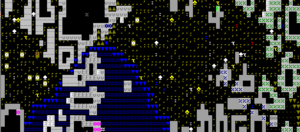- v50 information can now be added to pages in the main namespace. v0.47 information can still be found in the DF2014 namespace. See here for more details on the new versioning policy.
- Use this page to report any issues related to the migration.
v0.31:Caverns
| This article is about an older version of DF. |
Template:Human Caverns are huge natural underground tunnel systems, inhabited by strange and dangerous creatures. They go up, down, left, right, and about anywhere else. Vanilla worlds provide three cavern layers. Number, size and z-position can be altered in the Template:L parameters. The caverns will usually have open map edges, allowing all sorts of Template:L to migrate into and from the cavern. By exploring the caverns in adventure mode it is possible to travel large distances below the surface - the caverns effectively connect all sites that access them.
In subterranean biomes, Chasm, water, and lava mean land, water (pool), and magma (pipes) respectively.
Geography
The first cavern usually resides about 15 z-levels below the surface. [Verify] Each cavern layer spans multiple z-levels, and is filled with Template:L to a certain degree. This can range from a few pools at the bottom level (rarely even no water at all) to the whole layer being submerged, forming a gigantic underground sea, including Template:L and possibly camps of Template:L and other Template:L aquatic creatures.
The average amount of water cavern layers feature depends on your world generation settings, specifically
[CAVERN_LAYER_WATER_MIN:0]
[CAVERN_LAYER_WATER_MAX:100]
Underlying cavern layers tend to have more water than those above them. [Verify]
Beneath the third layer lies the Template:L.
Other Features
Exploring the underground world, you may find a variety of special geographical features. When your dwarves discover a feature, an announcement window will let you know of it.
Deep pits: deep pits are... deep pits, they go from one cavern level to the next, and they are a fixed shape, when they hit the next cavern level they end up 'merging' into it (no other way to explain it), and the top z-level, the z-level it hits the next cavern level, is un-muddied rough rock floor where the the normal space of the deep pit and the random rock spires of the cavern collide.
Magma pipes: Magma pipes are tubes extending from the Template:L and their shape is fixed, it's really random if you find one, it could extend to the top cavern, or even just a few z-levels.
Passages: Passages are natural tunnels connecting two layers by ramps and short, twisted tunnel sections.
Vegetation
Caverns will, from the topmost to the deepest, feature the following vegetation:
Level one: a benign (or as nice as caverns get) level, it has shrubs, Tower-caps, and Fungi wood.
Level two: a level filled with, in addition to the above, Goblin-caps, Spore trees, Black-caps, and Tunnel tubes.
Level three: a level lacking the trees the first level had, while still having those the second introduced, also has, Nether-caps, and Blood thorns.
Plants from recently discovered layers will also start sprouting in your artificially muddied areas (but not on the already muddied areas that the caverns are generated with).
Dangers
There are many, many dangerous Template:Ls in a cavern, including Template:Ls, Template:Ls, Template:Ls, Template:Ls, and others. Also, any cavern of sufficient size will be inhabited by Template:Ls, which can be both Template:L and hazard.
Benefits
Caverns provide ever regenerating resources in form of underground forests, animals to hunt, and fish. On breaching a cavern layer, a variety of ores and gems lining its walls will be revealed. The cavern floors are always Template:L, providing soil to a variety of underground Template:Ls. Also, underground caverns and the water they provide can be used in constructions and traps. Throwing your prisoners into a damp hellhole filled with ravaging beasts is a nice addition, too.
When should I start exploring?
Likely the best time is when you get your first migrant wave, and have a military. The first cavern usually has few hazardous monsters, apart from the occasional giant olm or toad and is pretty safe. The subsequent caverns will become increasingly Template:L, so don't dig too deep without making adequate preparation. As you can handle what tries to attack, presuming you don't have a Template:L to worry about. You can of course explore a cavern without a military, but you will likely get a bunch of dwarves killed.
Not all parts of a cavern are immediately visible; A good portion of a cavern is revealed once you breach it, but other parts remain hidden until your dwarves explore them. Since you often don't know what you'll find in a cavern, they can be exciting places, but also very dangerous.
